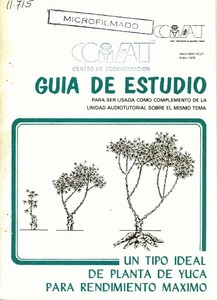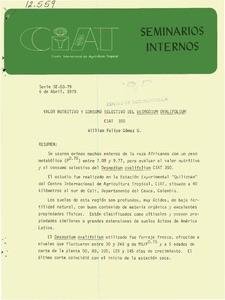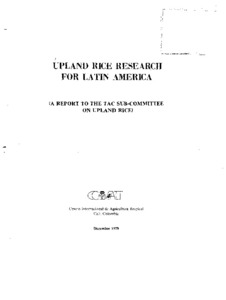CGIAR is the only worldwide partnership addressing agricultural research for development, whose work contributes to the global effort to tackle poverty, hunger and major nutrition imbalances, and environmental degradation.
It is carried out by 15 Centers, that are members of the CGIAR Consortium, in close collaboration with hundreds of partners, including national and regional research institutes, civil society organizations, academia, development organizations and the private sector.
The 15 Research Centers generate and disseminate knowledge, technologies, and policies for agricultural development through the CGIAR Research Programs. The CGIAR Fund provides reliable and predictable multi-year funding to enable research planning over the long term, resource allocation based on agreed priorities, and the timely and predictable disbursement of funds. The multi-donor trust fund finances research carried out by the Centers through the CGIAR Research Programs.
We have almost 10,000 scientists and staff in 96 countries, unparalleled research infrastructure and dynamic networks across the globe. Our collections of genetic resources are the most comprehensive in the world.
What we do
We collaborate with research and development partners to solve development problems. To fulfill our mission we:
- Identify significant global development problems that science can help solve
- Collect and organize knowledge related to these development problems
- Develop research programs to fill the knowledge gaps to solve these development problems
- Catalyze and lead putting research into practice, and policies and institutions into place, to solve these development problems
- Lead monitoring and evaluation, share the lessons we learn and best practices we discover;
- Conserve, evaluate and share genetic diversity
- Strengthen skills and knowledge in agricultural research for development around the world
Making a difference
We act in the interests of the world’s poorest and most vulnerable. Our track record spans four decades of research.
Our research accounted for US$673 million or just over 10 percent of the US$5.1 billion spent on agricultural research for development in 2010. The economic benefits run to billions of dollars. In Asia, the overall benefits of CGIAR research are estimated at US$10.8 billion a year for rice, US$2.5 billion for wheat and US$0.8 billion for maize.
It has often been cited that one dollar invested in CGIAR research results in about nine dollars in increased productivity in developing countries.
Sweeping reforms for the 21st century
Political, financial, technological and environmental changes reverberating around the globe mean that there are many opportunities to rejuvenate the shaky global food system. Developments in agricultural and environmental science, progress in government policies, and advances in our understanding of gender dynamics and nutrition open new avenues for producing more food and for making entrenched hunger and poverty history.
The sweeping reforms that brought in the CGIAR Consortium in 2010 mean we are primed to take advantage of these opportunities. We are eagerly tackling the ever more complex challenges in agricultural development. We are convinced that the science we do can make even more of a difference. To fulfill our goals we aim to secure US$1 billion in annual investments to fund the current CGIAR Research Programs.
CGIAR has embraced a new approach that brings together its strengths around the world and spurs new thinking about agricultural research for development, including innovative ways to pursue scientific work and the funding it requires. CGIAR is bringing donors together for better results and enabling scientists to focus more on the research through which they develop and deliver big ideas for big impact. As a result, CGIAR is more efficient and effective, and better positioned than ever before to meet the development challenges of the 21st century.
We are no longer the ‘Consultative Group on International Agricultural Research’. In 2008 we underwent a major transformation, to reflect this and yet retain our roots we are now known simply as CGIAR.
Members:
Resources
Displaying 12531 - 12535 of 12598Un tipo ideal de planta de yuca para rendimiento máximo [conjunto audiotutorial]
This audiotutorial unit (cassette, printed script, 76 color slides, study guide, self-evaluation test), prepared by the Communications Support Unit at CIAT, is available for use with a manually or automatically synchronized slide projector/cassette tape reccorder. Each unit is a vailabIe from the Distribution Office at a cost of US$ 50; photocopies of the study guide alone can be obtained from the Cassava Information Center. The objective of this unit is to present some of the results of research conducted by the physiology Section of CIATs Cassava Program.
Valor nutritivo y consumo selectivo del Desmodium ovalifolium CIAT 350
En la Estacion Experimental "Quilichao", del Centro Internacional de Agricultura Tropical (CIAT), depto. del Cauca, Colombia, se realizo un ensayo para evaluar el valor nutritivo y el consumo selectivo de Desmodium ovalifolium CIAT 350. Se usaron ovinos machos enteros de la raza Africanos, con un peso metabolico (P0.75) entre 7.89-9.77, a los cuales se suministro forraje fresco de D. ovalifolium a niveles de 30.245 g de MS/P(0.75) y de 5 edades de corte: 50, 80, 100, 125 y 145 dias; el ultimo corte coincidio con el inicio de la estacion seca.
Upland rice in Latin America : production, constraints and research proposals designed to improve productivity in the upland sector in the Latin American region
Pasture research and technology transfer in two Latin American cattle development programs: Ecuador and Panama
Se presentan resultados de la investigacion en produccion y utilizacion de pastos y forrajes que indican que en condiciones relativamente buenas de fertilidad natural y de retencion de humedad de los suelos, representadas por la region del litoral ecuatoriano entre Quevedo y Santo Domingo, es posible obtener aumentos de peso diario en novillos de engorde del orden de 450 g/animal y, con cargas de hasta 3 animales, lograr producciones promedio de carne de hasta 1,5 kg/ha/dia, o sea mas de 500 kg/ha/ano, de modo que los animales alcanzan el peso de mercado antes de los 2,5 anos de edad; tambi
La yuca como cultivo principal de un sistema de cultivo multiple
Multiple cropping, sequential cropping, intercropping, mixed intercropping, intercropping in rows, in strips, relayed intercropping, cropping patterns, monoculture, crop rotation and land equivalent ratio are defined. The characteristics of multiple cropping and intercropping with beans are discussed; for the latter problems of competence are discussed (light, CO2, water and nutrients). Some cultural practices are recommended for cassava/bean intercropping: soil and fertilization type, water availability, propagation material, and weed, pest and disease control.





